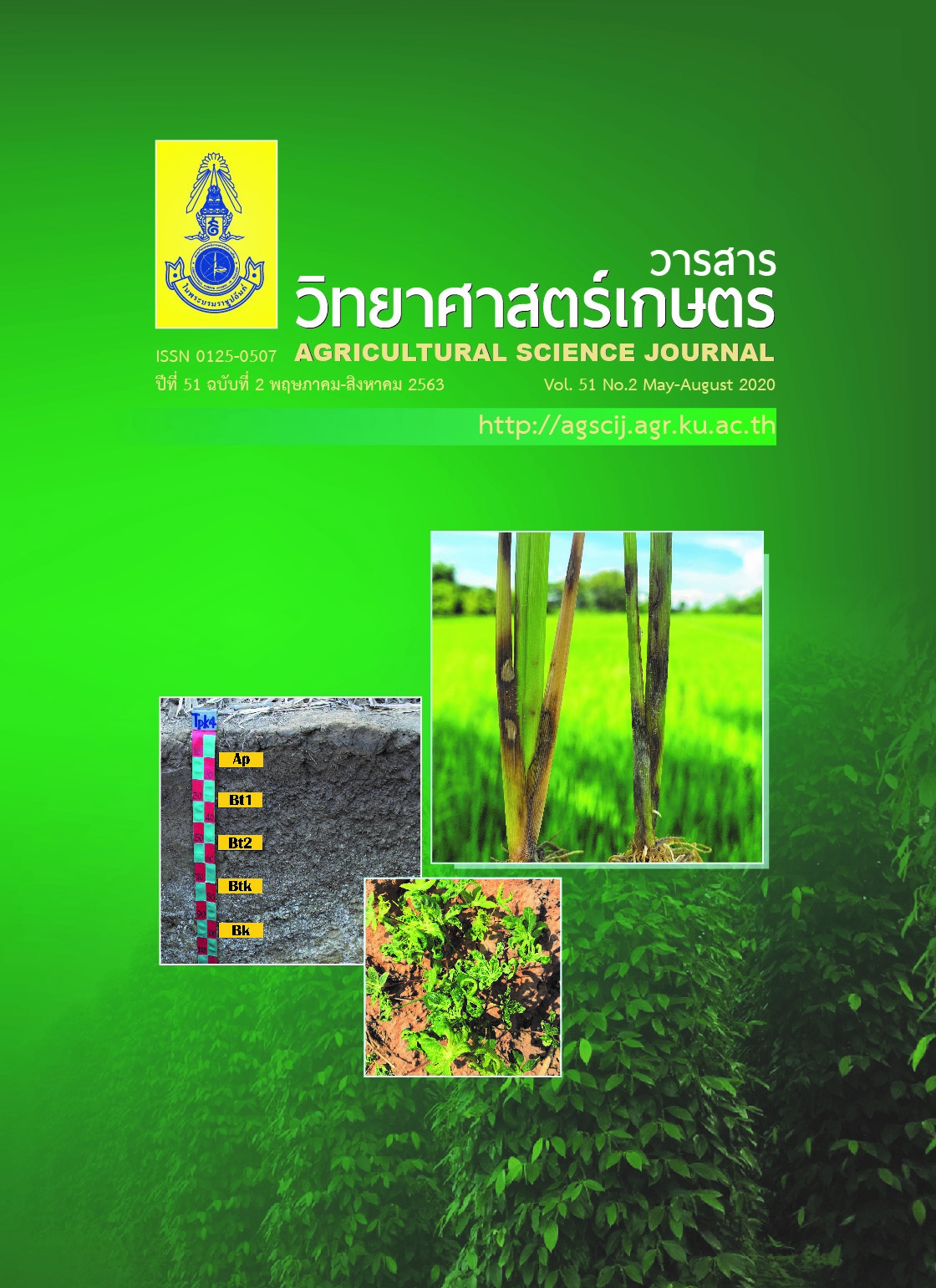การศึกษาอัตราการเกิดโรคใบด่างมันสำปะหลังในท่อนพันธุ์สะอาด
Main Article Content
บทคัดย่อ
งานทดลองนี้มีวัตถุประสงค์เพื่อเปรียบเทียบอัตราการติดโรคใบด่างมันสำปะหลังในพันธุ์เกษตรศาสตร์ 50 ห้วยบง 60 และ CMR-89 ที่ปลูกจากท่อนพันธุ์สะอาดกับท่อนพันธุ์ของเกษตรกร พันธุ์เกษตรศาสตร์ 50 โดยปลูกทดสอบที่อำเภอตาพระยา จังหวัดสระแก้ว ซึ่งเป็นเขตระบาดของโรค พบอัตราการเกิดโรคในแปลงที่ปลูกด้วยท่อนพันธุ์ของเกษตรกร สูงกว่าแปลงที่ปลูกด้วยท่อนพันธุ์สะอาด โดยอัตราการเกิดโรคของแปลงที่ปลูกด้วยท่อนพันธุ์ของเกษตรกรในเดือนที่ 2, 3 และ 4 คือ 49, 51 และ 55 เปอร์เซ็นต์ ตามลำดับ ในขณะที่ แปลงที่ปลูกด้วยท่อนพันธุ์สะอาดพันธุ์เกษตรศาสตร์ 50 ห้วยบง 60 และ CMR-89 พบอัตราการเกิดโรคในเดือนที่ 2, 3 และ 4 เดือน เฉลี่ย 0.8, 1.3 และ 2.5 เปอร์เซ็นต์ ตามลำดับ เมื่อตรวจสอบสาเหตุการเกิดโรค พบว่า แปลงที่ปลูกโดยการใช้ท่อนพันธุ์ของเกษตรกร มีสาเหตุมาจากการใช้ท่อนพันธุ์ที่เป็นโรคร่วมกับแมลงหวี่ขาวถ่ายทอดเชื้อไวรัส สำหรับแปลงท่อนพันธุ์สะอาดทั้ง 3 พันธุ์ พบเพียงลักษณะอาการที่มีสาเหตุมาจากแมลงหวี่ขาวนำเชื้อไวรัสในช่วงที่มันสำปะหลังมีอายุ 2–3 เดือนเท่านั้น นอกจากนี้ ได้ทำการสุ่มเก็บตัวอย่างใบของต้นที่ไม่แสดงอาการในมันสำปะหลังที่ปลูกด้วยท่อนพันธุ์สะอาดทั้ง 3 พันธุ์ และตรวจสอบเชื้อไวรัส SLCMV ด้วยเทคนิค polymerase chain reaction (PCR) ผลการตรวจสอบ พบว่า เปอร์เซ็นต์อาการแฝงของไวรัสในมันสำปะหลัง พันธุ์ CMR-89 ห้วยบง 60 และ เกษตรศาสตร์ 50 คือ 10, 3.5 และ 3 เปอร์เซ็นต์ ตามลำดับ ดังนั้น งานทดลองนี้ชี้ให้เห็นว่า การใช้ท่อนพันธุ์สะอาดปลูกในพื้นที่ที่มีการระบาดของโรคสามารถช่วยลดอัตราการเกิดโรคได้
Article Details
เอกสารอ้างอิง
Alabi, O.J., F.O. Ogbe, R. Bandyopadhyay, P.L. Kumar, A.G. Dixon, J.D. Hughes and R.A. Naidu. 2008. Alternate hosts of African cassava mosaic virus and East African cassava mosaic Cameroon virus in Nigeria. Arch Virol. 153: 1743–1747.
Attathom, S. 2009. Virus Disease of Plant. Petrung Kanpim, Nonthaburi, Thailand. 206 pp. (In Thai)
Brown, J.K., F.M. Zerbini, J. Navas-Castillo, E. Moriones, R. Ramos-Sobrinho, J.C. Silva, E. FialloOlivé, R.W. Briddon, C. Hernández-Zepeda, A. Idris, V.G. Malathi, D.P. Martin, R. RiveraBustamante, S. Ueda and A. Varsani. 2015. Revision of Begomovirus taxonomy based on pairwise sequence comparisons. Arch Virol. 160: 1593–1619.
CIAT. 2018. GCP21 calls for regional approach to stem the outbreak of cassava mosaic disease in Southeast Asia. Available Source: https://blog.ciat.cgiar.org/press-release-gcp21-calls-for-regional-approach-to-stem-the-outbreak-of-cassava-mosaic-disease-insoutheast-asia/, October 12, 2020.
Childs, A.H.B. 1957. Trials with virus resistant cassavas in Tanga province, Tanganyika. E. Afr. Agr. J. 23: 135–137.
Doyle, J.J. 1987. A rapid DNA isolation procedure for small quantities of fresh leaf tissue. Phytochem Bull. 19: 11–15.
Dubern, J. 1994. Transmission of African cassava mosaic geminivirus by the whitefly (Bemisia tabaci). Trop. Sci. 34: 82–91.
Fauquet, C., D. Fargette and J.C. Thouvenel. 1988. Some aspects of the epidemiology of African cassava mosaic virus in Ivory Coast. Trop. Pest Manag. 34: 92–96.
Food and Agriculture Organization of the United Nations. 2019. The current status of SLCMV in Thailand. Available Source: https://www.ippc.int/en/countries/thailand/pestreports/2019/03/the-current-status-of-slcmv-in-thailand/, April 10, 2019.
Hemniam, N., K. Saokham, S. Roekwan, S. Hunsawattanakul, J. Thawinampan and W. Siriwan. 2019. Severity of cassava mosaic disease in resistance and commercial varieties by grafting. In Proc. the 14th National Plant Protection Conference. 12–14 November 2019. p. 163. (in Thai)
Jameson, J.D. 1964. Cassava Mosaic Disease in Uganda. East. Afr. Agr. For. J. 29: 208–213.
Legg, J.P. 2010. Epidemiology of a whitefly-transmitted cassava mosaic geminivirus pandemic in Africa, pp. 233–257. In P. Stansly and S. Naranjo, eds. Bemisia: Bionomics and Management of a Global Pest. Springer, Dordrecht.
Legg, J.P., B. Owor, P. Sseruwagi and J. Ndunguru. 2006. Cassava mosaic virus disease in east and central Africa: epidemiology and management of a regional pandemic. Virus Res. 67: 355–418.
Minato, N., S. Sok, S. Chen, E. Delaquis, I. Phirun, V.X. Le, D.D. Burra, J.C. Newby, K.A. Wyckhuys and S.D. Haan. 2019. Surveillance for Sri Lankan cassava mosaic virus (SLCMV) in Cambodia and Vietnam one year after its initial detection in a single plantation in 2015. PLOS ONE. 14: e0212780.
Office of Agricultural Economics. 2019a. Cassava production capacity information. Available Source: http://impexp.oae.go.th/service/export.php?S_YEAR=2562&E_YEAR=2562&PRODUCT_GROUP=5263&wf_search=&WF_SEARCH=Y, October 12, 2020.
Office of Agricultural Economics. 2019b. Cassava cultivation area information. Available Source: http://www.oae.go.th/assets/portals/1/fileups/prcaidata/files/%E0%B8%9E%E0%B8%B1%E0%B8%99%E0%B8%98%E0%B8%B8%E0%B9%8C%E0%B8%A1%E0%B8%B1%E0%B8%99%E0%B8%AA%E0%B8%B3%E0%B8%9B%E0%B8%B0%E0%B8%AB%E0%B8%A5%E0%B8%B1%E0%B8%87%2061.pdf, October 12, 2020.
Office of Agricultural Economics. 2020. Situation analysis of cassava mosaic disease. Available Source: https://www.nabc.go.th/disaster/baidang, October 12, 2020.
Otim-Nape, G.W., A. Bua, J.M. Thresh, Y. Baguma, S. Ogwal, G. Ssemakula, G. Acola and B. Byabakama. 2000. The current pandemic of cassava mosaic virus disease in Uganda. In D.G. Jones, eds. The Epidemiology of Plant Diseases. Springer, Dordrecht.
Otim-Nape, G.W., J.M. Thresh and M. Shaw. 1998. The incidence and severity of cassava mosaic virus disease in Uganda: 1990-92. Trop. Sci. 38: 25–37.
Riordan, K.A. 2019. 10 insect pests that threaten the world’s plants. Available Source: https://www.kew.org/read-and-watch/insect-pests-biggest-threat-plants, April 10, 2019.
Shah, M.M.R. and T.X. Liu. 2013. Feeding experience of Bemisia tabaci (Hemiptera: Aleyrodidae) affects their performance on different host plants. PLOS ONE. 8: e77368.
Siriwan, W., J. Jimenez, N. Hemniam, K. Saokham, D. Lopez-Alvarez, A.M. Leiva, A. Martinez, L. Mwanzia, L.A. Becerra Lopez-Lavalle and W.J. Cuellar. 2020. Surveillance and diagnostics of the emergent Sri Lankan cassava mosaic virus (Fam. Geminiviridae) in Southeast Asia. Virus Res. 285: 197959.
Sseruwagi, P., W.S. Sserubombwe, J.P. Legg, J. Ndunguru and J.M. Thresh. 2004. Methods of surveying the incidence and severity of cassava mosaic disease and whitefly vector populations on cassava in Africa: a review. Virus Res. 100: 129–142.
Storey, H.H. 1936. Virus diseases of East African plants. E. Afr. Agr. J. 1: 333–337.
Terry, E. 1976. Description and evaluation of cassava mosaic disease in Africa. In Proc. An Interdisciplinary Workshop. Ibadan, Nigeria. pp. 53–54.
Thresh, J.M. and R.J. Cooter. 2005. Strategies for controlling cassava mosaic virus disease in Africa. Plant Pathol. 54: 587–614.
Tokunaga, H., T. Baba, M. Ishitani, I.K. Kasumi, O.K. Le, K. Maejima, S. Namba, K. Natsuaki and N.V. Dong. 2018. Sustainable management of invasive cassava pests in Vietnam, Cambodia, and Thailand, pp. 131–157. In M. Kokubun and S. Asanuma, eds. Crop Production under Stressful Conditions. Springer, Singapore.
Waller, J.M., J.M. Lenné and S.J. Waller. 2002. Plant Pathologist’s Pocketbook. CABI Pub., New York, USA. 528 pp.
Wang, H.L., X.Y. Cui, X.W. Wang, S.S. Liu, Z.H. Zhang and X.P. Zhou. 2016. First report of Sri Lankan cassava mosaic virus infecting cassava in Cambodia. Plant Dis. 100: 1029.
Yadava, P., G. Suyal and S.K. Mukherjee. 2010. Begomovirus DNA replication and pathogenicity. Curr. Sci. 98: 360–368.


